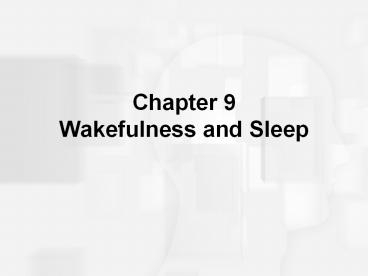Chapter 9 Wakefulness and Sleep - PowerPoint PPT Presentation
1 / 28
Title:
Chapter 9 Wakefulness and Sleep
Description:
Animals generate endogenous 24 hour cycles of wakefulness and sleep. ... Atonia. Sleep Disorders. Insomnia. Sleep apnea. Narcolepsy. Cataplexy. REM behavior disorder ... – PowerPoint PPT presentation
Number of Views:95
Avg rating:3.0/5.0
Title: Chapter 9 Wakefulness and Sleep
1
Chapter 9Wakefulness and Sleep
2
Rhythms of Waking and Sleep
- Animals generate endogenous 24 hour cycles of
wakefulness and sleep.
3
Rhythms of Waking and Sleep
- Endogenous circadian rhythms
4
Fig. 9-2, p. 267
5
Rhythms of Waking and Sleep
- Mechanisms of the circadian rhythms include the
following - The Suprachiasmatic nucleus.
- Genes that produce certain proteins.
- Melatonin levels.
6
Rhythms of Waking and Sleep
- Suprachiasmatic nucleus (SCN)
7
Fig. 9-4, p. 269
8
Rhythms of Waking and Sleep
- Two types of genes are responsible for generating
the circadian rhythm. - Period - produce proteins called Per.
- Timeless - produce proteins called Tim.
9
Fig. 9-5, p. 270
10
Rhythms of Waking and Sleep
- The SCN regulates waking and sleeping by
controlling activity levels in other areas of the
brain.
11
Stages of Sleep And Brain Mechanisms
- Sleep is a specialized state that serves a
variety of important functions including - conservation of energy.
- repair and restoration.
- learning and memory consolidation.
12
Stages of Sleep And Brain Mechanisms
- The electroencephalograph (EEG) allowed
researchers to discover that there are various
stages of sleep.
13
Stages of Sleep And Brain Mechanisms
- Alpha waves
- Stage 1 sleep
- Stage 2 sleep
- Sleep spindles
- K-complexes
- Stage 3 and Stage 4
- Non-REM (NREM)
14
Stages of Sleep And Brain Mechanisms
- Rapid eye movement sleep (REM)
15
Fig. 9-9, p. 276
16
Stages of Sleep And Brain Mechanisms
- Various brain mechanisms are associated with
wakefulness and arousal. - reticular formation
- Pontomesencephalon
- locus coeruleus
- basal forebrain
- Hypothalamus
- Orexin
17
Table 9-1, p. 280
18
Fig. 9-11, p. 279
19
Fig. 9-12, p. 280
20
Stages of Sleep And Brain Mechanisms
- During REM sleep
- Activity increases in the pons (triggers the
onset of REM sleep), limbic system, parietal
cortex and temporal cortex. - Activity decreases in the primary visual cortex,
the motor cortex, and the dorsolateral prefrontal
cortex.
21
Stages of Sleep And Brain Mechanisms
- Atonia
22
Sleep Disorders
- Insomnia
- Sleep apnea
- Narcolepsy
- Cataplexy
- REM behavior disorder
23
Stages of Sleep And Brain Mechanisms
- Parasomnias
- Night terrors
- Sleep talking
- Sleepwalking
- Sleep eating
- Sleep driving
24
Why Sleep? Why REM? Why Dreams?
- Conserve energy
- Restorative processes
25
Why Sleep? Why REM? Why Dreams?
- Enhancing learning and strengthening memory
26
Why Sleep? Why REM? Why Dreams?
- Humans spend one-third of their life asleep.
- One-fifth of sleep time is spent in REM.
27
Why Sleep? Why REM? Why Dreams?
- REM deprivation
- REM Rebound
- Research is inconclusive regarding the exact
functions of REM.
28
Why Sleep? Why REM? Why Dreams?
- Accuracy of dreams
- Two biological theories of dreaming include
- The activation-synthesis hypothesis.
- 2. The clinico-anatomical hypothesis.

